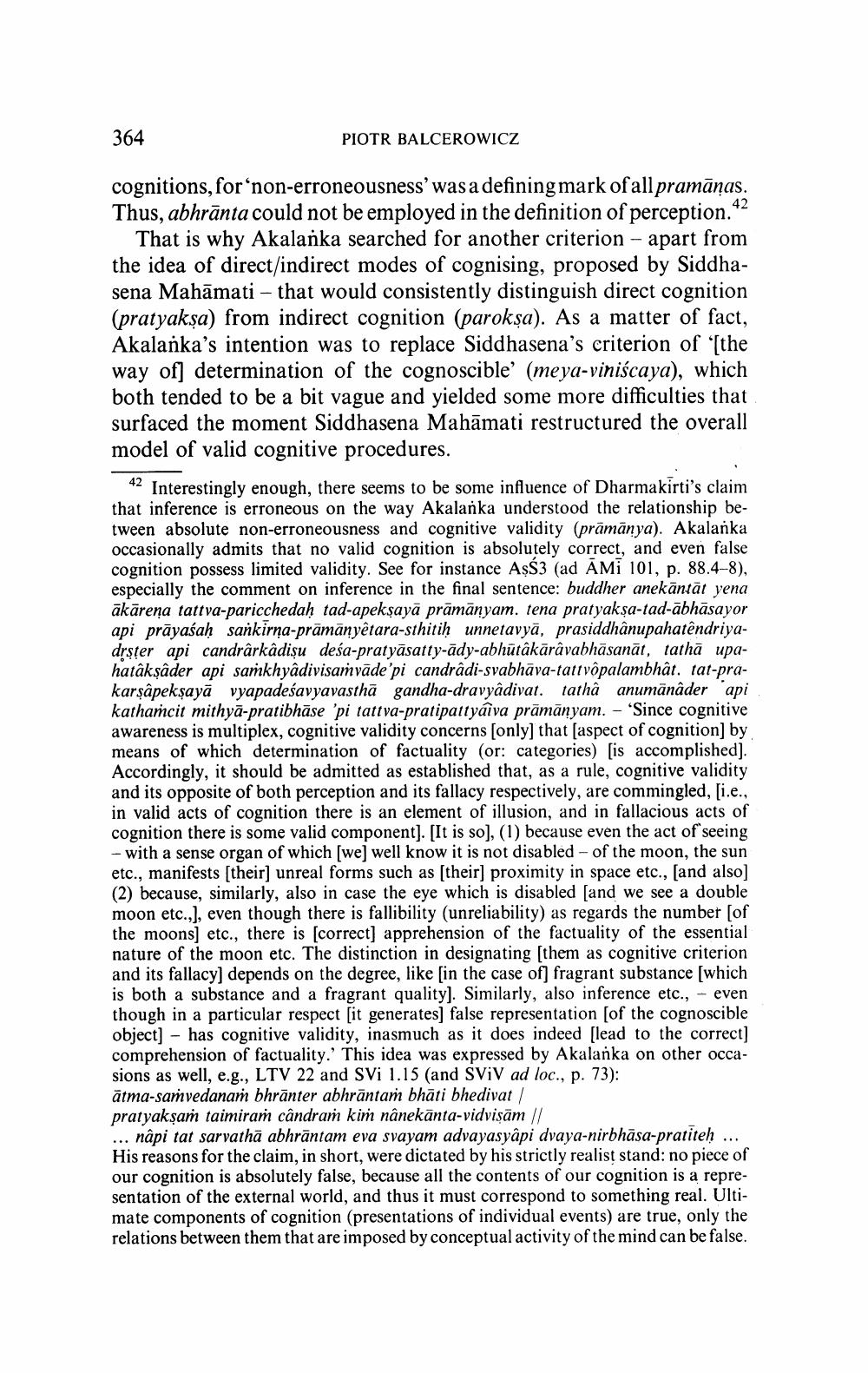________________
364
PIOTR BALCEROWICZ
cognitions, for non-erroneousness' was a defining mark of all pramānas. Thus, abhrānta could not be employed in the definition of perception. 42
That is why Akalanka searched for another criterion - apart from the idea of direct/indirect modes of cognising, proposed by Siddhasena Mahāmati – that would consistently distinguish direct cognition (pratyakșa) from indirect cognition (parokşa). As a matter of fact, Akalanka's intention was to replace Siddhasena's criterion of 'sthe way of] determination of the cognoscible' (meya-viniscaya), which both tended to be a bit vague and yielded some more difficulties that surfaced the moment Siddhasena Mahāmati restructured the overall model of valid cognitive procedures.
42 Interestingly enough, there seems to be some influence of Dharmakirti's claim that inference is erroneous on the way Akalanka understood the relationship between absolute non-erroneousness and cognitive validity (prāmānya). Akalanka occasionally admits that no valid cognition is absolutely correct, and even false cognition possess limited validity. See for instance A$S3 (ad AMi 101, p. 88.4-8), especially the comment on inference in the final sentence: buddher anekāntāt yena ākārena tattva-paricchedah tad-apeksayā prāmānyam. tena pratyakşa-tad-ābhāsayor api prāyaśaḥ sankirņa-prāmānyétara-sthitih unnetavyā, prasiddhanupahatêndriyadrster api candrarkâdişu deśa-pratyāsatty-ādy-abhūtākārâvabhāsanāt, tathā upahatakşâder api samkhyâdivisavāde'pi candradi-svabhāva-tatt vôpalambhật. tat-prakarşâpekṣayā vyapadeśavyavasthā gandha-dravyâdivat. tatha anumānâder 'api kathaṁcit mithya-pratibhāse 'pi tattva-pratipattyáiva prāmānyam. - 'Since cognitive awareness is multiplex, cognitive validity concerns [only] that (aspect of cognition) by means of which determination of factuality (or: categories) [is accomplished). Accordingly, it should be admitted as established that, as a rule, cognitive validity and its opposite of both perception and its fallacy respectively, are commingled, [i.e., in valid acts of cognition there is an element of illusion, and in fallacious acts of cognition there is some valid component]. [It is so), (1) because even the act of seeing - with a sense organ of which (we) well know it is not disabled - of the moon, the sun etc., manifests (their) unreal forms such as (their) proximity in space etc., [and also] (2) because, similarly, also in case the eye which is disabled (and we see a double moon etc.,), even though there is fallibility (unreliability) as regards the number (of the moons) etc., there is (correct] apprehension of the factuality of the essential nature of the moon etc. The distinction in designating [them as cognitive criterion and its fallacy) depends on the degree, like in the case of] fragrant substance (which is both a substance and a fragrant quality). Similarly, also inference etc., - even though in a particular respect [it generates) false representation (of the cognoscible object] - has cognitive validity, inasmuch as it does indeed [lead to the correct] comprehension of factuality. This idea was expressed by Akalanka on other occasions as well, e.g., LTV 22 and SVi 1.15 (and SViV ad loc., p. 73): ātma-samvedanam bhrānter abhrāntam bhāti bhedivat/ pratyakşam taimiram cândram kim nânekānta-vidvisām // ... nâpi tat sarvathā abhrāntam eva svayam advayasyâpi dvaya-nirbhāsa-pratiteh .. His reasons for the claim, in short, were dictated by his strictly realist stand: no piece of our cognition is absolutely false, because all the contents of our cognition is a representation of the external world, and thus it must correspond to something real. Ultimate components of cognition (presentations of individual events) are true, only the relations between them that are imposed by conceptual activity of the mind can be false.




